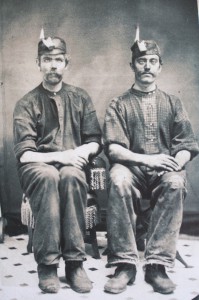Last November, I went to Wyoming to see where the Brodd family first settled upon their arrival in America. I went to a museum in Hanna, but weather prevented me from going to see the cemetery and what’s left of the small town of Carbon. I made plans to return! Last Friday was the day; I organized a field trip for my mom, my sister Lisa and my daughter Katie.
Background Carbon was the first commercial coal mine in Wyoming. The Transcontinental Railroad, completed in 1869, was deliberately routed to go through Carbon. For the first few years of the Transcontinental Railroad’s operation, Carbon was the single most important source of coal for powering the steam locomotives. Every train on its way east or west stopped at Carbon to load up with coal.
Remember learning about the Transcontinental Railroad back in school? It never occurred to me until last Friday what a direct impact it had on my family history.
My great-great-great-uncle J.W. Johnson emigrated from Sweden in about 1869. He worked in the Midwest for a few years, then got hired on at Fort Fetterman, Wyoming as the head carpenter. That was a dangerous job in those days. Even though he was a civilian, he got “hazard pay” of $75 per month. He worked there for two years and saved up enough money to buy land. He bought a “milk ranch” near Carbon and sold milk for the miners at the nearby town of Carbon. He also sent money back to Sweden for his sister Gustafva (my great-great-grandmother) and her family to come to America.
Gustafva and her husband Anders Gustaf Brodd were living a typical peasant existence back in Sweden. He was enrolled as a soldier, meaning he had a small working farm provided to him but not much else. Their prospects for improving their lot in life were slim. At Gustafva’s urging, they left for America, making Anders a “wanted man” for going AWOL. They arrived in Carbon in the middle of summer in 1875.
Right at about the time the Brodd’s arrived in Wyoming, J.W.’s wife Matilda died in childbirth. Gustafva was herself nursing a baby at the time (August Charlotta, born in August, 1874). Gustafva took her newborn niece Matilda “Tillie” Johnson to her breast and probably saved her life (Tillie lived to the ripe old age of 98!).

The Brodds ended up staying in Carbon for seven years. They were working and saving money to buy land of their own. Life in Carbon was incredibly tough. There were no trees and no water, just sagebrush prairie, the coal mines, and the rugged town of Carbon. We believe that Anders worked in the mines for at least some amount of time. By the 1880 census, he is listed as “coal weighmaster”, so it seems that he had a job up top after a time. From family legend, we know that Gustafva earned money by baking bread and selling it to the miners.
For more about life at Carbon, I highly recommend “Them Was the Days” by Martha Ferugson McKeown. As we were driving to Wyoming, mom and Lisa took turns reading excerpts from it out loud. We learned that many families in Carbon had to live in dug-outs (kind of like sod houses, but without the sod!). Children worked in the mine under deplorable conditions. Water was shipped to Carbon from nearby Medicine Bow, and it cost 25 cents to fill your whiskey barrel full. It was dangerous working in the mines, but it was also dangerous just to live in Carbon, too. Disease was rampant. My great-grandmother Clara was born two years after the family arrived in Carbon. The Brodd family was lucky they all survived their years in Carbon. The cemetery we visited was testament to the dangers involved.
Eventually, the coal mines at Carbon were depleted and the mining activity moved north and west to the town of Hanna. The railroad was re-routed, too. By 1904, Carbon was pretty much done. Fires had burned many of the buildings down and the ones that remained were hauled off to Hanna. Today it is less that a ghost town – more like a cemetery and a nearby archaeological site.
Our visit Please look at the captions on the photos below for all the details. We spent a couple of hours exploring the cemetery and what was left of the town, then went to the museum in Hanna. We met the director Nancy Anderson there and her husband Victor. One of Victor’s great-great-Uncle’s was in a business partnership with J.W. Johnson – so amazing to find a family connection still there after all these years! While we were eating our picnic lunch, Nancy shared a photo with us that might include J.W. Johnson in it (I’ll see what I can do to verify it). We looked around at the museum exhibits and enjoyed visiting with Nancy and Victor.
After our day in Carbon, we stopped by the cemetery in Laramie to find J.W. Johnson’s grave. We found it with no trouble at all. He is buried alongside his second wife Annie, his daughter Evelyn, Evelyn’s son Donald, and an infant child of Tillie’s.
What an awesome day we had. I think the four of us are in awe of the hardships of our ancestors.
One last interesting factoid. We went on our trip in Mom and Dad’s Volvo, the one they bought on our trip to Sweden last year. It’s the same car we took to Nebraska a couple of weeks ago. That car has now been everywhere that Anders and Gustafva Brodd have been. Freaky!
For further reading:
- Wikipedia First Transcontinental Railroad
- Wyoming State Historical Society Carbon, Wyoming
- Hanna Basin Museum
Here’s a photo gallery from our trip.

It was an amazing day! How I wish we had asked Grandma about her early life!